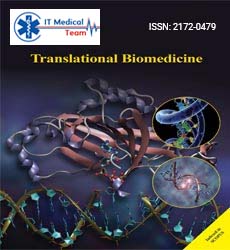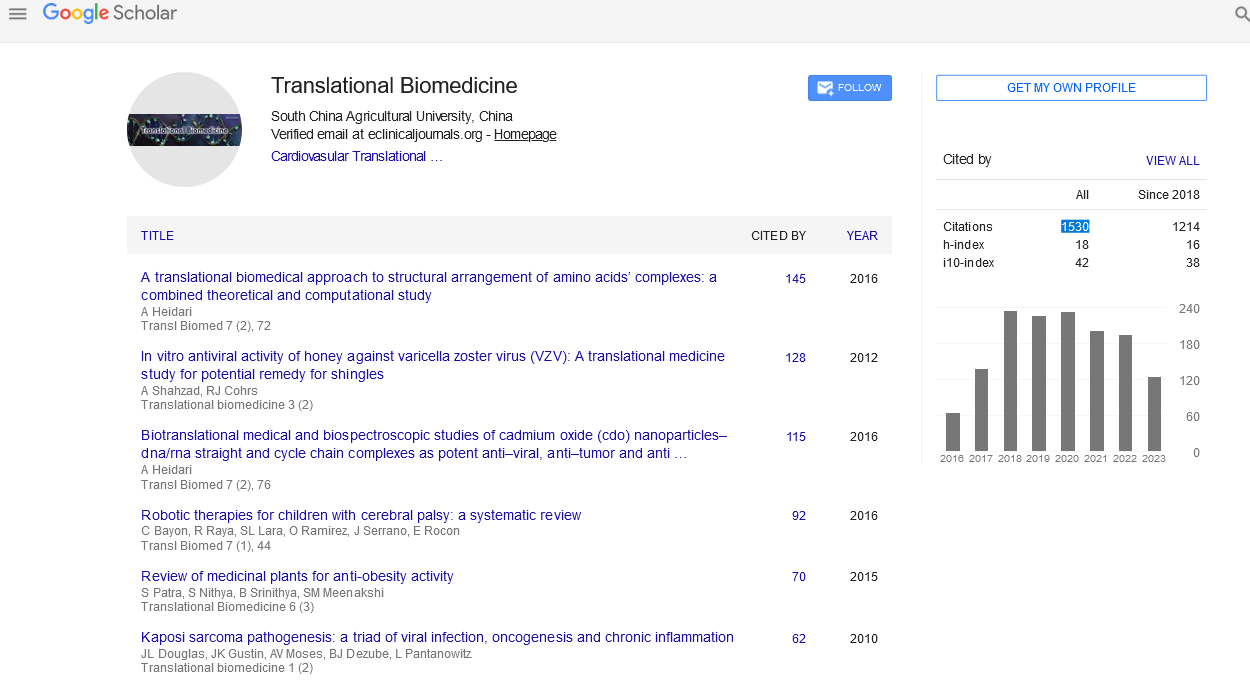Mini Article - (2023) Volume 14, Issue 3
Implications for Personalized Medicine and Circulating Glycaemia Biomarkers in Diabetes Treatment
John Miranda*
Department of Precision Medicine, Brazil
*Correspondence:
John Miranda, Department of Precision Medicine,
Brazil,
Email:
Received: 01-Mar-2023, Manuscript No. Iptb-23-13610;
Editor assigned: 03-Mar-2023, Pre QC No. Iptb-23-13610 (PQ);
Reviewed: 16-Mar-2023, QC No. Iptb-23-13610;
Revised: 20-Mar-2023, Manuscript No. Iptb-23-13610 (R);
Published:
27-Mar-2023, DOI: 10.36648/2172- 0479.14.03.290
Abstract
The personalized medicine model seeks to identify unique characteristics within each patient that can serve as a basis for disease characterization and specialized treatment rather than managing those with a specific diagnosis in accordance with established guidelines. Hemoglobin A1C, fructosamine, and anhydroglucitol are among the circulating biomarkers of glycaemia that are utilized in the medical management of diabetes and are discussed in this article. The areas in which biomarker results do not correlate with anticipated results based on actual mean glycaemia are the focus of the discussion. Inconstancy among genuine and expected aftereffects of the different biomarker tests addresses chances to distinguish already vague subcategories of diabetes and gatherings of patients that fit into these subcategories. Finally, research areas that would further advance the field of personalized diabetes medicine are suggested for these subcategories.
Keywords
1, 5-Anhydroglucitol; Diabetes biomarkers; Glycation gap; Hemoglobin
A1C variability; Hemoglobin glycation index; Personalized medicine
Introduction
Illness the executives depend on normalized rules. This paradigm
does not take into account the characteristics of each individual
patient [1]. In contrast to this approach, personalized medicine
makes an effort to comprehend patient characteristics as the
disease progresses, with the idea that these characteristics
influence the course of the disease and the most effective
treatments [2]. This article reviews three circulating biomarkers
of diabetes management and proposes using these biomarkers
to define diabetes subgroups, despite the fact that there are
certainly many factors in patients with diabetes that would lead
to true personalization of therapy. The subgroups could then
represent upcoming research projects that have the potential to
advance personalized diabetes medicine.
A1C hemoglobin
HbA1c can be used as a reliable indicator of glycaemic control in
the previous months, according to a number of studies. HbA1c
is formed when glucose permanently attaches to hemoglobin
A over the 120-day lifespan of the erythrocyte. The HbA1c test measures the ratio of hemoglobin HbA1c to total hemoglobin A.
No diabetes patients have a normal level of less than 6%, while
uncontrolled diabetes patients can have levels that are higher
than 10%. The HbA1c test is the primary determinant of glucose
control in virtually every clinical trial evaluating diabetes outcomes
[3]. The Diabetes Control and Complications Trial was the first
significant clinical trial. 1441 individuals with type 1 diabetes
were divided into two groups and followed for an average of 6.5
years in this study. During that time, the conventional therapy
group received standard care and maintained an HbA1c of
9.0%. An average HbA1c of 7.1% was achieved by the intensive
therapy group on an aggressive insulin regimen. Retinopathy,
nephropathy, and neuropathy were all reduced by 76%, 54%,
and 60%, respectively, in the intensive therapy group. As a result,
this clinical trial demonstrated a correlation between lowering
HbA1c levels and reducing diabetes complications. The United
Kingdom Prospective Diabetes Study4 was the second significant
clinical trial. In this study, 3867 people with type 2 diabetes
were randomly assigned to either a conventional diet-only or
intensive group and followed for ten years. A similar reduction
in micro-vascular complications and a separation in hemoglobin A1C between the two groups were observed [4]. A subsequent
analysis revealed that a significant reduction in a number of
macro vascular complications, including myocardial infarction,
stroke, amputation, and heart failure, was associated with the
benefit of a 1% reduction in HbA1c. Professional organizations
were able to incorporate HbA1c targets into their diabetes
guidelines on the basis of these trials. The European Association
for the Study of Diabetes and the American Association of Clinical
Endocrinologists have endorsed a stricter goal of HbA1c 6.5%,
while the American Diabetes Association has advocated for a
goal of HbA1c 7.0%. Trials have raised questions about how low
the HbA1c target should be [5]. A particular intensive diabetes
management strategy may not be beneficial to patients with
advanced diabetes and cardiovascular disease. The HbA1c test
has a number of drawbacks. The fact that the HbA1c test does not
take into account glycaemic variability is a significant flaw. Derr
and colleagues compared the self-monitoring of blood glucose
(SMBG) data, calculated mean glucose levels, and measured
HbA1c levels of 256 patients.9 some patients' SMBG data showed
low glucose variability, while others had extremely high glucose
variability [6]. The correlation between mean glucose levels and
HbA1c was unaffected by this level of glucose variability, though.
Erythrocyte and hemoglobin function is related to another flaw in
the HbA1c test. The precision of the test relies on a steady 120-
day normal erythrocyte life expectancy. Anemias that extend or
abbreviate the typical life expectancy influence test unwavering
quality by influencing the time period for erythrocyte glycosylation.
When patients with variants of hemoglobin S, C, or E were tested,
several laboratory procedures also produced unexpected results.
Luckily, endeavours to normalize research center strategies have
defeated this issue [7]. Only 5% of laboratories continue to employ
techniques that significantly interfere with hemoglobinopathy.
The different reference ranges that were given to each laboratory
technique were a bigger problem than just that. For the same
patients, different labs provided distinct HbA1c results. The initial DCCT-based high-performance liquid chromatography assay has
been an important step in standardizing the various methods
to a common reference, which has been achieved through the
National Glycohemoglobin Standardization Program (NGSP).
Fructosamine
Albumin is the most common of the gyrated serum proteins
measured here. The best correlation between the fructosamine
level and average glucose levels over the previous 10–14 days is
found. In a study with 72 participants, Lindsey and colleagues
found that weekly fructosamine testing, in addition to HbA1c
testing, did not offer a clinical advantage over blood glucose
monitoring alone. Clinically, fructosamine is utilized in patients
who are known to have a condition that makes HbA1c testing
temperamental or to distinguish transient changes in a patient's
glucose control [8]. There is less fructosamine information
when contrasted with HbA1c information, however numerical
connection can be made between fructosamine, HbA1c, and
normal glucose values. Fructosamine, HbA1c, and average
glucose values were compared in two fascinating studies that
were relevant to the idea of personalized medicine and were
published by Cohen and colleagues. In these articles, the
presence of a glycosylation hole (GG) is characterized as real
HbA1c less HbA1c anticipated from fructosamine [9]. A wide
GG distribution range was found when HbA1c and fructosamine
were measured on the same sample of 153 individuals. A 1%
increment in GG was related with a 2.9-overlap expansion in the
gamble of nephropathy stage (p = .0014).20 Cohen and relates
thusly assessed the expected heritability of GG, taking note of
recently referred to prove for hereditary assurance of HbA1c level
in solid endlessly twins with diabetes.18,21 Glycosylation hole
was all the more firmly corresponded between monozygotic (r =
.65) than dizygotic (r = .48) twins, and 69% of populace difference
in GG was heritable [10].
References
- Goldstein DE, Little RR, Lorenz RA, Malone JI, Nathan D et al. (2004) Tests of glycaemia in diabetes. Diabetes Care 27:1761–1773.
Indexed at, Google Scholar, Crossref
- Stratton IM, Adler AL, Neil HA, Matthews DR, Manley SE et al. (2000) Association of glycaemia with macro vascular and micro vascular complications of type 2 diabetes (UKPDS 35): prospective observational study. BMJ 321:405–412.
Indexed at, Google Scholar, Crossref
- Nathan DM, Kuenen J, Borg R, Zheng H, Schoenfeld D et al. (2008) A1c-Derived Average Glucose Study Group Translating the A1C assay into estimated average glucose values. Diabetes Care 31:1473–1478.
Indexed at, Google Scholar, Crossref
- Herman WH, Ma Y, Uwaifo G, Haffner S, Kahn SE et al. (2007) Diabetes Prevention Program Research Group. Differences in A1C by race and ethnicity among patients with impaired glucose tolerance in the diabetes prevention program. Diabetes Care 30:2453–2457.
Indexed at, Google Scholar, Crossref
- McCarter RJ, Hempe JM, Gomez R, Chalew SA (2004) Biological variation in HbA1c predicts risk of retinopathy and nephropathy in type 1 diabetes. Diabetes Care 27:1259–1264.
Indexed at, Google Scholar, Crossref
- Lindsey CC, Carter AW, Mangum S, Greene D, Richardson A et al. (2004) A prospective, randomized, multicentered controlled trial to compare the annual glycaemic and quality outcomes of patients with diabetes mellitus monitored with weekly fructosamine testing versus usual care. Diabetes Technol Ther 6:370–377.
Indexed at, Google Scholar, Crossref
- Cohen RM, Holmes YR, Chenier TC, Joiner CH (2003) Discordance between HbA1c and fructosamine: evidence for a glycosylation gap and its relation to diabetic nephropathy. Diabetes Care 26:163–167.
Indexed at, Google Scholar, Crossref
- Buse JB, Freeman JL, Edelman SV, Jovanovic L, McGill JB (2003) Serum 1,5-anhydroglucitol (GlycoMark): a short-term glycaemic marker. Diabetes Technol Ther 5:355–363.
Indexed at, Google Scholar, Crossref
- Yamanouchi T, Akanuma Y, Toyota T, Kuzuya T, Kawai T (1991) Comparison of 1,5-anhydroglucitol, HbA1c, and fructosamine for detection of diabetes mellitus. Diabetes 40:52–57.
Indexed at, Google Scholar, Crossref
- Dungan KM, Buse JB, Largay J, Kelly MM, Button EA et al. (2006) 1,5-anhydroglucitol and postprandial hyperglycemia as measured by continuous glucose monitoring system in moderately controlled patients with diabetes. Diabetes Care 29:1214–1219.
Indexed at, Google Scholar, Crossref
Citation: Miranda J (2023) Implications for Personalized Medicine and Circulating Glycaemia Biomarkers in Diabetes treatment. Transl Biomed, Vol. 14 No. 3:115





